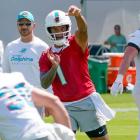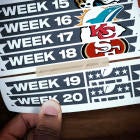
This time last year, almost every conversation in NFL circles was in some way connected to Deflategate. After the Indianapolis Colts alerted the NFL that the New England Patriots might be playing with under-inflated footballs, the league ran what essentially amounted to a sting operation to see whether or not that was true.
After a months-long investigation, not much in the way of firm, conclusive evidence was turned up, but Patriots quarterback Tom Brady was still suspended for the first four games of the season and the Patriots were forced to forfeit their 2016 first-round pick. Brady's suspension was upheld after an appeals hearing in front of commissioner Roger Goodell. That suspension was overturned by a federal court, though, and the NFL later announced it would collect PSI data from random games throughout the season in an effort to better police what happens with footballs used in games.
On Tuesday evening, the commissioner said that the league did not keep and will not release the data that was collected during the season. Here, via NFL PR, is the portion of an interview on The Rich Eisen Show related to the issue:
On if the NFL conducted a scientific test to measure footballs and PSI throughout this season:
No, Rich, what the league did this year was what we do with a lot of rules and policies designed to protect the integrity of the game, and that's to create a deterrent effect. We do spot checks to prevent and make sure the clubs understand that we're watching these issues. It wasn't a research study. They simply were spot checks. There were no violations this year. We're pleased that we haven't had any violations and we continue the work, obviously, to consistently and importantly enforce the integrity of the game and the rules that are designed to protect it.
It was initially thought that these PSI "spot checks" were designed to study the effects of weather on psi (pound-force per square inch, which is essentially a measurement of how much air pressure is in footballs), since much of Brady and the Patriots' claim that they did nothing wrong during last year's AFC title game centered on the effects of the Ideal Gas Law. Below are two excerpts of the Patriots' response to the Wells Report (Ted Wells' investigation that served as the basis for Brady's suspension and the forfeiture of New England's first-round pick) focused on that very issue.
First:
The League had advance notice of the Colts concerns about game football psi. They also knew there would be inclement weather at the game (pg. 53, fn. 31). League personnel never considered the inevitable impact of the colder temperatures outside, which would inevitably drop footballs set at 12.5 psi pre-game to below regulation soon after being moved to the field. The Wells Report (pg.113) validates the science behind this conclusion. The League should have been aware of this going into the game, but it appears that the League never considered the impact of weather on psi or on the enforcement of Rule 2 in this game or any game. Using Ideal Gas Law calculations, footballs set pre-game in 71º indoor temperatures at the high end of the Rule 2 range — 13.5 psi — will drop below 12.5 when the outside temperature is at or below 52º. It is safe to assume that countless NFL games have therefore used below-regulation footballs — and no one has even noticed. The League is, however, “generally aware” of the impact of heat and cold on the psi of footballs, having adopted a protocol which prevents footballs from being placed in front of field-level heaters. There was a violation of this protocol that arose during the Carolina game in Minnesota during the 2014 season, when NFL officials told ball boys for both teams not to continue to put footballs in front of heaters — an evident attempt to tamper with the footballs in violation of the rules. That led to only a warning to the teams.
Second:
The average of the Prioleau (Logo gauge) measurements — and using an average makes sense given the non-repeatability of even a single gauge — is 11.49 psi, precisely what would have been predicted by the Ideal Gas Law. According to the League’s consultants, the Ideal Gas Law predicted the Patriots footballs which started at 12.5 would have measured between 11.32 and 11.52 psi at the end of the first half (pg. 113). The average of these 11 footballs is within or above that range, as are the actual psi of 8 of the 11 footballs. If air had been intentionally released from each football before the game, these numbers would be significantly lower.
That's a pretty detailed accounting of how cold weather affects the PSI of footballs. When the NFL announced it would actually measure PSI throughout the season, it sure seemed like a response to those claims. According to Goodell, though, it had nothing to do with that, and was simply meant to deter teams from using under-inflated footballs. Frankly, that seems extraordinarily unlikely.
If the data collection was really meant to be a deterrent, though, then I would expect that we'll see it happen again next season and all seasons in the future. Collecting data for just one season wouldn't really do much good to deter ball deflation in the future, after all. If we don't see the NFL continue this policy, it would cast a shadow of great doubt over Goodell's statement that the collection of data this season had nothing to do with the Patriots' Ideal Gas Law claims.
Wink of the CBS Eye to Yahoo! Sports





















